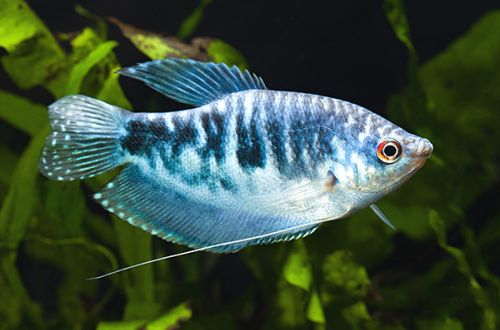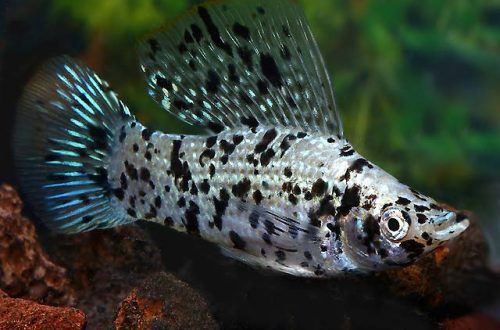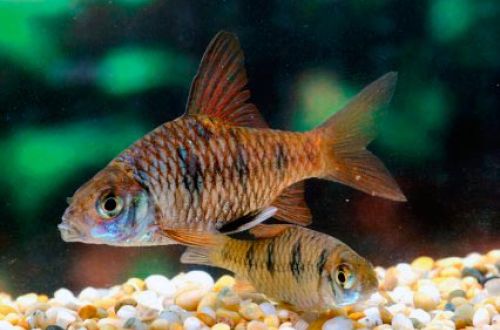
Marble Gourami
The Marble Gourami, scientific name Trichopodus trichopterus, belongs to the Osphronemidae family. It has an original body pattern with a combination of blue and dark blue colors, outwardly reminiscent of veins in marble. Beautiful appearance and unpretentiousness determined its popularity among aquarists around the world.

This species is an artificially bred form of the Blue Gourami. Breeders selectively bred the desired traits and fixed them for several generations, as a result, new color variations were obtained, among which are Golden and Platinum Gourami.
Contents
Habitat
Blue Gourami was bred artificially in the 70s of the last century in the USA, and is currently bred mainly in Southeast Asia. Does not occur in the wild.
Description
The fish is medium in size, has an elongated somewhat oval body, laterally compressed. The fins are large in comparison with the body, rounded. The ventral fins in the process of evolution have changed to thread-like sensitive processes, with the help of which Gurami studies the world around him. Like other representatives of the Labyrinths, it has a special organ that allows it to absorb atmospheric air by swallowing bubbles from the surface of the water.
The coloration is pale blue with dark spots of irregular shape, reminiscent of a marble pattern. Small light specks are noticeable all over the body, which together gives a unique ornament.
Food
In home aquariums, all types of dry industrial food are accepted, as well as meat products – live and frozen. The basis of the diet can be specialized high-quality food designed for gourami (widely available in pet stores), in combination with live food, such as bloodworms, mosquito larvae, etc. Feed once a day if meat products are in the diet, or according to the instructions on food packaging.
Maintenance and care
A group of fish will need a spacious tank of about 150 liters, although for one fish a volume of 40–50 is quite enough. The design of the aquarium should include a tight-fitting lid, under which an air layer with increased temperature and humidity is formed, which minimizes the risk of damage to the labyrinth organ of the fish during the swallowing of atmospheric air.
Recommended equipment is as follows: filter, aerator, heater, lighting system. There are combined filters that spray air bubbles instead of an aerator, so the need for the latter may disappear. Keep in mind that the fish prefer very little water movement, a strong current will lead to stress and excessive physical exertion in an attempt to cope with it. When choosing a filter, choose a productive model, but at the same time it must create a weak flow of water.
In the design, the presence of shelters in the form of grottoes, rocks, snags and loose vegetation cover is mandatory. Optimal arrangement of plants along the side and back walls of the aquarium. Floating plants are welcome. The substrate is preferably dark, it will emphasize the color of the fish.
Social behavior
Adults exhibit individual behavioral traits ranging from shyness to aggression, which can create problems in the future, especially if a very temperamental fish is caught. However, the dislike is directed primarily towards newcomers, and to a lesser extent towards those with whom Gurami grew up. There is a clear intraspecific hierarchy, a stronger male becomes a dominant individual and can attack his weak relatives. Single, pair or harem content seems to be optimal.
As neighbors, you can choose from large and calm fish, such as some catfish. Active individuals provoke aggression, and very small fish can be perceived as food / prey.
Sexual differences
The male is distinguished by a more elongated and pointed dorsal fin, in females it is short and rounded.
Breeding / breeding
Breeding is quite simple. If you keep only two fish, then spawning can be carried out in the main aquarium, otherwise it is recommended to use a spawning tank, where a couple will be temporarily located, and then their offspring.
The incentive for spawning is the inclusion of meat products in the diet and an increase in water temperature to 26 ° C. If there are few plants in the aquarium, including floating ones, the fish may not start spawning. Over time, the female fills with eggs, and the male proceeds to build a nest of bubbles and pieces of plants, usually in the corner of the tank. After the construction is completed, the courtship period begins, the male clings to the female, touches her, inviting her to the nest. An adult is able to release up to 700 eggs, which are immediately fertilized, the male collects them and transfers them to the nest, the female should be immediately removed from the aquarium. The male guards the masonry and attacks everyone who comes too close, his attacks can be fatal for the attacked. When the fry are born, it is time for the male to leave his offspring and join the female, otherwise they will become his prey. Feed the fry with microfeed, brine shrimp, ciliates.
Diseases
A very hardy species, able to adapt to various conditions, survive a short-term deterioration in water quality. In a balanced aquarium, health problems usually do not occur. Systematic violation of the diet, long breaks in the supply of food, a significant deterioration in living conditions will inevitably lead to outbreaks of diseases. Read more about symptoms and treatments in the Aquarium Fish Diseases section.





